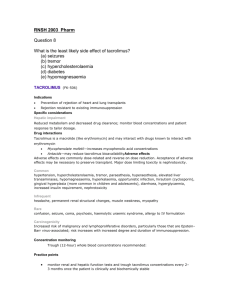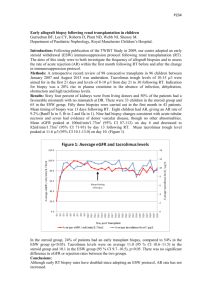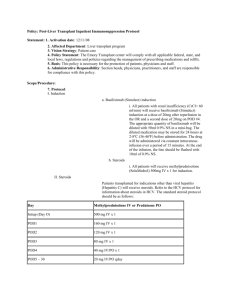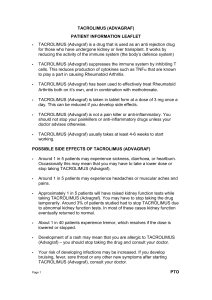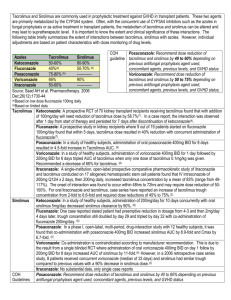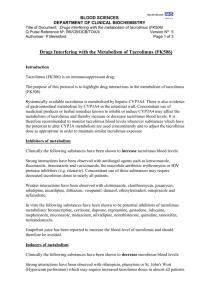DOCX ENG
advertisement
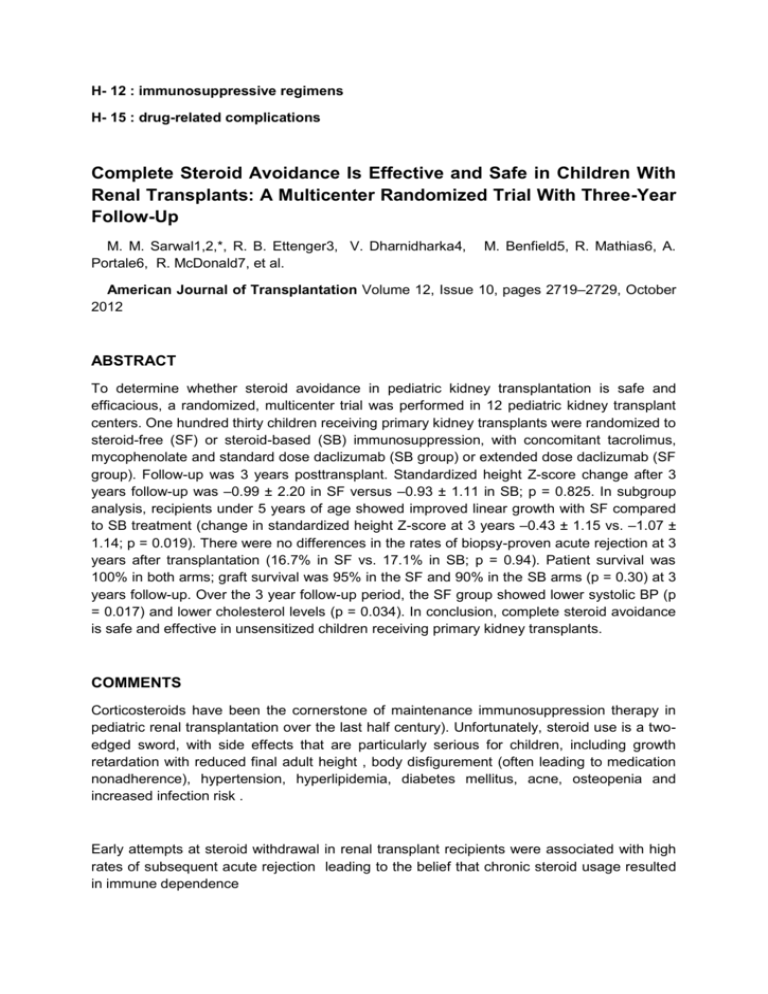
H- 12 : immunosuppressive regimens H- 15 : drug-related complications Complete Steroid Avoidance Is Effective and Safe in Children With Renal Transplants: A Multicenter Randomized Trial With Three-Year Follow-Up M. M. Sarwal1,2,*, R. B. Ettenger3, V. Dharnidharka4, Portale6, R. McDonald7, et al. M. Benfield5, R. Mathias6, A. American Journal of Transplantation Volume 12, Issue 10, pages 2719–2729, October 2012 ABSTRACT To determine whether steroid avoidance in pediatric kidney transplantation is safe and efficacious, a randomized, multicenter trial was performed in 12 pediatric kidney transplant centers. One hundred thirty children receiving primary kidney transplants were randomized to steroid-free (SF) or steroid-based (SB) immunosuppression, with concomitant tacrolimus, mycophenolate and standard dose daclizumab (SB group) or extended dose daclizumab (SF group). Follow-up was 3 years posttransplant. Standardized height Z-score change after 3 years follow-up was –0.99 ± 2.20 in SF versus –0.93 ± 1.11 in SB; p = 0.825. In subgroup analysis, recipients under 5 years of age showed improved linear growth with SF compared to SB treatment (change in standardized height Z-score at 3 years –0.43 ± 1.15 vs. –1.07 ± 1.14; p = 0.019). There were no differences in the rates of biopsy-proven acute rejection at 3 years after transplantation (16.7% in SF vs. 17.1% in SB; p = 0.94). Patient survival was 100% in both arms; graft survival was 95% in the SF and 90% in the SB arms (p = 0.30) at 3 years follow-up. Over the 3 year follow-up period, the SF group showed lower systolic BP (p = 0.017) and lower cholesterol levels (p = 0.034). In conclusion, complete steroid avoidance is safe and effective in unsensitized children receiving primary kidney transplants. COMMENTS Corticosteroids have been the cornerstone of maintenance immunosuppression therapy in pediatric renal transplantation over the last half century). Unfortunately, steroid use is a twoedged sword, with side effects that are particularly serious for children, including growth retardation with reduced final adult height , body disfigurement (often leading to medication nonadherence), hypertension, hyperlipidemia, diabetes mellitus, acne, osteopenia and increased infection risk . Early attempts at steroid withdrawal in renal transplant recipients were associated with high rates of subsequent acute rejection leading to the belief that chronic steroid usage resulted in immune dependence In pediatric transplantation, it is possible to withdraw or avoid steroids if other immunosuppressive agents are given in large doses . However, such a strategy could induce a state of overimmunosuppression with an increased risk of such complications as posttransplant lymphoproliferative disorder . A steroid-free (SF) protocol for pediatric kidney transplant recipients was developed at Stanford University. This protocol replaced steroids with extended daclizumab induction for the first 6 months after transplantation, followed by a two-drug tacrolimus and mycophenolate mofetil maintenance immunosuppression protocol Subjects were randomized (1:1) to a traditional low-dose SB immunosuppression regimen (steroids, standard daclizumab induction until the second month posttransplant, and maintenance immunosuppression with tacrolimus (Prograf®, Astellas Pharma, Tokyo, Japan) and MMF (CellCept®, Hoffman-La Roche, Basel, Switzerland) or a SF immunosuppression regimen (prolonged daclizumab induction until the sixth month posttransplant, tacrolimus and MMF). For both the SF arm and the SB arm, oral tacrolimus was administered from immediately preoperatively to recipients >5 years of age at a starting dose of 0.1 mg/kg/dose BID for living donor recipients and 0.1 mg/kg/dose QD for deceased donor recipients. Recipients <5 years of age received tacrolimus from immediately preoperatively at 0.15 mg/kg/dose BID (two preoperative doses) for living donor recipients and 0.15 mg/kg/dose QD (one preoperative dose) for deceased donor recipients. Postoperatively, the oral tacrolimus dose was 0.07 mg/kg/dose BID adjusted subsequently to achieve target levels of 12–14 ng/ml from day 0 to 7, 10–12 ng/ml from week 2 to 8, 7–10 ng/ml from week 9 to 12 and 5–7 ng/ml after 12 weeks. Evidence of tacrolimus toxicity on any protocol biopsy resulted in a further lowering of the tacrolimus target level to 4–6 ng/ml before the first year and 3–5 ng/ml after the first year posttransplantation. Intravenous MMF was dosed at 1200 mg/m2/day in two divided doses preoperatively and for the first 48 h postoperatively. Oral MMF was dosed at 600–900 mg/m2/day in two divided doses; the dose range allowed for dose titration according to tolerability and side effects of MMF. This regimen was used in both the SF and the SB arm. Extended daclizumab (Zenapax®, Hoffman-La Roche, Basel, Switzerland) dosing was the investigational product for evaluation (BB-IND-10127 held by MS from 1999 to 2004, and NIAID from 2004 till date). The dosing for daclizumab for the SF arm was 2 mg/kg pretransplant followed by 1 mg/kg at weeks 2, 4, 6, 8, 11 and months 4, 5 and 6. For the SB arm, daclizumab was given at a dose of 1 mg/kg peri-operatively and then at week 2, 4, 6 and 8. In the SB arm, MMF and tacrolimus were dosed in a manner similar to the SF protocol. In the SB arm, prednisone 10 mg/kg was given peri-operatively followed by 2 mg/kg/day in subjects weighing <40 kg and 1.5 mg/kg/day in subjects weighing >40 kg. The prednisone dosing was tapered as follows: by the end of weeks 1, 2, 4, 6, 12 and 16, dosages were 0.5, 0.4, 0.3, 0.2, 0.15 and 0.1 mg/kg/day, respectively. The prednisone dose of 0.1 mg/kg was achieved by no later than 6 months posttransplant. By 1 year after transplantation, biopsy-proven acute clinical rejection occurred in 13.3% of SF versus 11.4% of SB patients (p = 0.74) . Also when borderline changes were included, the incidence of rejection was comparable between both study groups (20.0% in SF vs. 18.6% in SB; p = 0.84) by 1 year after transplantation. Over the 3 years of follow-up, there was no significant difference in the rate of biopsy-proven acute clinical T cell mediated rejection (16.7% in SF vs. 17.1% in SB; p = 0.94). Also when borderline changes were included, no difference was noted at 3 years after transplantation (26.7% in SF vs. 28.6% in SB; p = 0.81) Complete steroid avoidance, combined with effective induction, tacrolimus and mycophenolate mofetil, provides a new therapeutic standard for safe and effective immunosuppression for renal transplantation of low-risk children with end stage renal disease. Pr. Jacques CHANARD Professor of Nephrology
